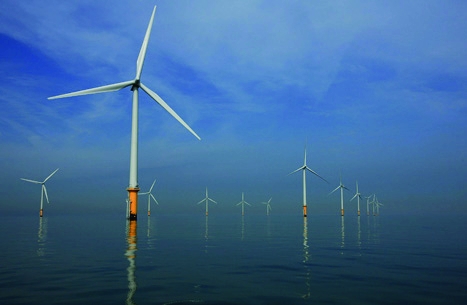Not even Alexander the Great would find it easy to untangle the complicated strands that make up UK government energy policy. The Macedonian leader legendarily solved the intractable problem of loosening the complicated Gordian Knot tying an ox-cart to a post (in order to claim a vacant throne) by getting out his sword and cutting through it. If faced with the current tangle over how various renewable energies are supported, we think he’d probably give up in disgust and try to think of another use for his sword. In which case, the assembled masses of the Department of Energy and Climate Change would be best advised to find something sturdy to hide behind.
The story we’re being fed this morning is that the government is cutting support for onshore wind and solar energy and increasing funding for offshore wind. This, we’re told, is because onshore wind and solar technology is mature, whereas — as we’ve seen with the recent withdrawal of RWE Innogy from its Atlantic Array project in the Bristol Channel — offshore wind still faces considerable technical challenges.

Unpacking this claim is quite a challenge. Yes, there are certainly big changes coming up in how renewable energies are supported: but these changes were happening anyway, because the mechanism is switching from Renewable Obligation Certificates (ROCs), where (to simplify somewhat) energy generators claim an extra top-up payment per megawatt-hour on top of the market rate, to a strike price, where suppliers are guaranteed a minimum amount for the energy they generate.
The ‘changes’ mentioned today are in the strike prices, which have been reduced or increased relative to the draft amounts issued in back in July. And there are changes — but they aren’t very dramatic. Instead of onshore wind producers being paid £100/MWhr, as was proposed in the July draft, they’ll be paid £95/MWhr from 2014; this will reduce to £90/MWhr from 2017, rather than £95/MWhr. The offshore wind strike price starts at £155 in 2014, goes down to £150/MWhr in 2016, and then to £140/MWhr in 2017. That’s unchanged from July. Repeat, unchanged. Where this claim that support for offshore wind is increasing is anyone’s guess. Large solar goes from £120/MWhr to £110/MWhr.
Confused? Don’t worry, you’re in company.
Does this represent a reduction in the overall price for onshore wind and solar? Seeing as we’re going from a system where gradually-declining ROC payments top up the fluctuating market price to one where the government mandates an overall price, it’s very difficult to say. On the one hand, apples; on the other, oranges. Add into this that the switch from ROC to strike price is gradual — producers can opt for one or the other up to 2017, when strike prices become compulsory — and it just gets more tangled.
It is instructive to compare these strike prices with those for nuclear, however. The agreement for Hinkley Point C sets the price at £92.50/MWhr from 2018, so all we can say with certainty is that when the station is operating, nuclear will be slightly more expensive than onshore wind, and somewhat cheaper than offshore. Incidentally, the strike price for wave and tidal is £305/MWhr, reflecting the difficulty of placing complex machinery in an extremely hostile environment and getting electricity from them in a medium which is itself conductive, while also keeping up maintenance. Yes, it is harder than splitting the atom.
It’s also not entirely true to state that this is government support, as the money is raised through electricity bills. It’s a moot point, as billpayers are also taxpayers, so the support is coming from the same pockets (yours and mine) and it’ll take a while for the effects of this new form of payment to be apparent. But there is quite definitely a huge amount of spin coming along with this announcement; cynics would say that this is more of an attempt to appease rural opponents of wind farms than anything else.
Meanwhile, and in somewhat of a surprise, the government has released its latest National Infrastructure Plan, with £375billion of investment in road, rail, energy, communications and water projects over the next five years, of which the insurance industry has guaranteed to supply £25billion. This appears to be welcome news: it represents definite progress on urgent projects, including the Wylfa nuclear power station, although some may not welcome the proposed sell-off of the UK’s 40 per cent stake in Eurostar — another asset which could be argued is strategic, potentially passing into overseas ownership. But at least it sets out what civil engineers will be tackling in coming years, and gives us some insight into what the country will look like when it’s done. It’ll be interesting to see where the rest of that £375billion comes from.




Red Bull makes hydrogen fuel cell play with AVL
Formula 1 is an anachronistic anomaly where its only cutting edge is in engine development. The rules prohibit any real innovation and there would be...